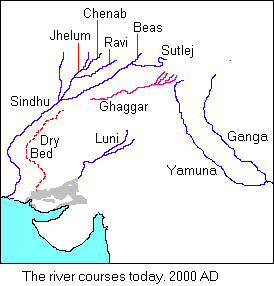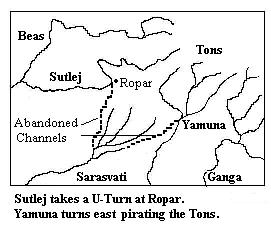
Saraswati River
It is clear from the vedic texts, that the Rigvedic people lived on the banks of a river called the Saraswati.
The major rivers of north-west (Punjab, Sindh, Rajasthan & Gujrat) were: Saraswati, Sindhu (Indus), Shatadru (Sutlej), Vipasa (Beas), Vitasa (Jhelum), Parushni (Ravi), Asikni (Chenab), Yamuna, Drishadwati and Lavanavati. All rivers have changed their courses since Vedic times. Of these, three rivers: Saraswati, Drishadwati and Lavanavati no longer exist.
There were about 300 cities (plus so many supporting towns & villages) along the banks of saraswati. It was called Saraswati-Sindhu Civilization.
Saraswati: The Goddess of Knowledge
 It was on the banks of Saraswati, that the Vedic ashrams
thrived. She was thus called the goddess of knowledge. (Remember goddess Saraswati
is always portrayed with water in background, blooming lotus, white swans, and bathing
elephants.).
It was on the banks of Saraswati, that the Vedic ashrams
thrived. She was thus called the goddess of knowledge. (Remember goddess Saraswati
is always portrayed with water in background, blooming lotus, white swans, and bathing
elephants.).
The Rig Veda praises the river as:
ambitambe naditambe devitambe saraswati
The best of mothers, best of rivers, best of godesses, Oh
Saraswati!
Course of River Saraswati
In Vedic times the rivers Beas, Jhelum, Ravi & Chenab joined Sindhu, to form one channel from Himalayas to the Arabian Sea.
Saraswati and her tributary rivers: Yamuna, Sutlej, Drishadvati and Lavanavati formed the other channel from Himalayas to the Arabian Sea. Saraswati was a mighty river with three sources in the Himalayas. Her bed was as vast as 10 km in some places. The river course was dotted with lakes and ponds.
In the very early days, Saraswati met the Arabian Sea at the Rann of Kachh. After the level of Rann increased, she crossed the Rann to join Arabian Sea at the gulf of Khambat.
Here is the proposed course of the northwestern rivers during Vedic times:
|
 |
The river had flowed for millennia originating from the Har-ki-dun glacier, in the Bandarpunch mass of W.Garhwal of the Himalayas flowing through Kurukshetra, Kalibangan, Ganweriwala (in Bahawalpur province, Pakistan), Rann of Kutch (close to Dholavira) and through the Nall lake into the Gulf of Khambat (close to Lothal). The river had dried up in 1500 B.C. in many stretches.
 |
The reasons for this drying up are: river capture and aandhi (sandstorms).
Yamuna (erstwhile Chambal) which is a tributary of the Ganga, captured the Saraswati source at Paontasaheb (where there is a famous Sikh shrine in Punjab); thus the popular belief of Sangam at Prayag is based on groundtruth: the Yamuna captured Saraswati and took her to join Ganga at Prayag, near Allahabad. Thus, due to river capture, Saraswati was deprived of the perennial source of molten glaciers from the Himalayas. The aandhi phenomenon also accounted for the submergence of the river bed by sandstorms. As the river started drying-up, people starting migrating eastwards towards the Ganga-Yamuna doab (e.g. Alamgirpur and Kunal) and southwards towards the Godavari river, traversing the Arabian sea-coast. (Daimabad is a cognate archaeological site located on the banks of Pravara river which is a tributary of the Godavari river, near Nasik).
Late Vedic Period: Tectonic movements pushed up the Aravali hills, in northern Rajasthan. This changed the drainage pattern of the Northwest drastically. Saraswati lost her major tributaries, Yamuna and Sutlej. Sutlej turned west and joined Beas-Sindhu system, and Yamuna started migrating east to join Ganga.
During Mahabharat times: The volume of water flowing down the Saraswati had reduced. The waters of Saraswati did not make it upto the sea. Yamuna at this time, partly flowed westwards to meet Saraswati and partly flowed eastwards to meet Ganga.
At the time of Krishna's birth Yamuna was not as mighty as it is today. Hence it must have been possible for Vasudev to cross the river, with the new born Krishna in his arms.
It is described in Mahabharat, that Balaram travelled along the almost dry banks of Saraswati, and then along the banks of Yamuna, from Prabhas (Somnath) to Mathura.
After Mahabharat times: Yamuna now pirated Saraswati's sources and flowed into Ganga. Because Yamuna brought the waters of Saraswati to Ganga, the Sagam is called as the Triveni Sangam of Ganga, Yamuna and Saraswati. Ganga now took the importance of Saraswati and the title of goddess.
Today, Ghaggar; a puny seasonal river, occupies some parts of Saraswati's dry beds. The dry vast bed called the Hakra-Nara channels lie in the western Rajasthan.
Impact of Saraswati's demise on the population
Saraswati had such an impact on the lives, even after her disappearence, that many rivers were later renamed after her. River Argandab (now in Afghanistan) was named Saraswati. The lower channels of the river Luni in Gujrat were also renamed as Saraswati. Another river born in the Himalayas, (one of the sources of Vedic Saraswati) but flowing down in Assam is also called Saraswati.
The demise of Saraswati, was near fatal for the Saraswati civilization. The scarcity of water forced people to migrate. Saraswati - Sindhu civilization did not vanish. There was a shift of population after the economy around the Saraswati river collapsed. People moved to east to the Ganga-Yamuna plains, west, northwest and south to Godavari plains.
